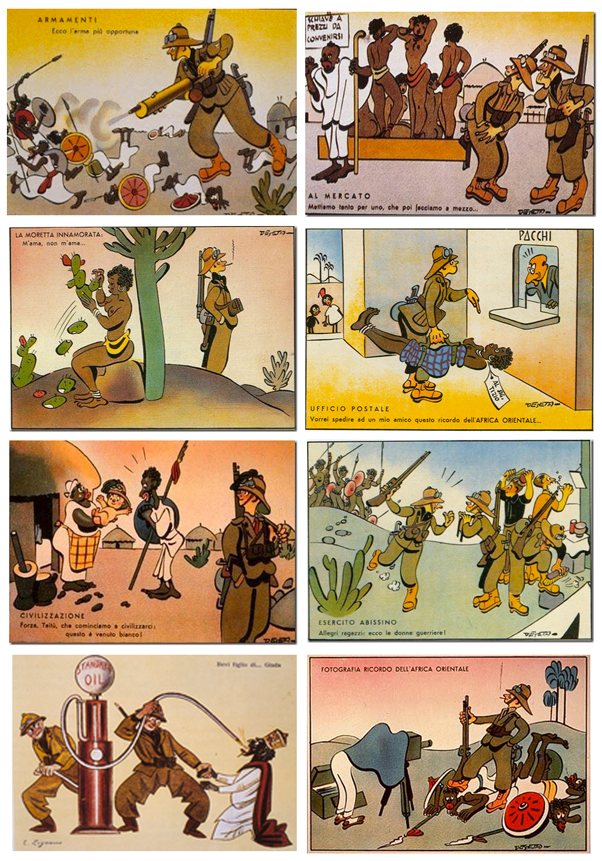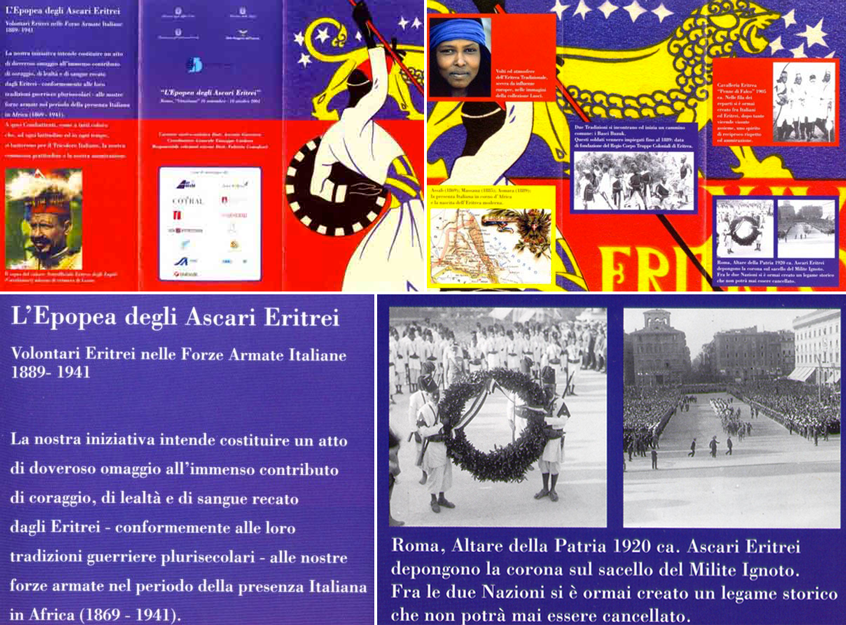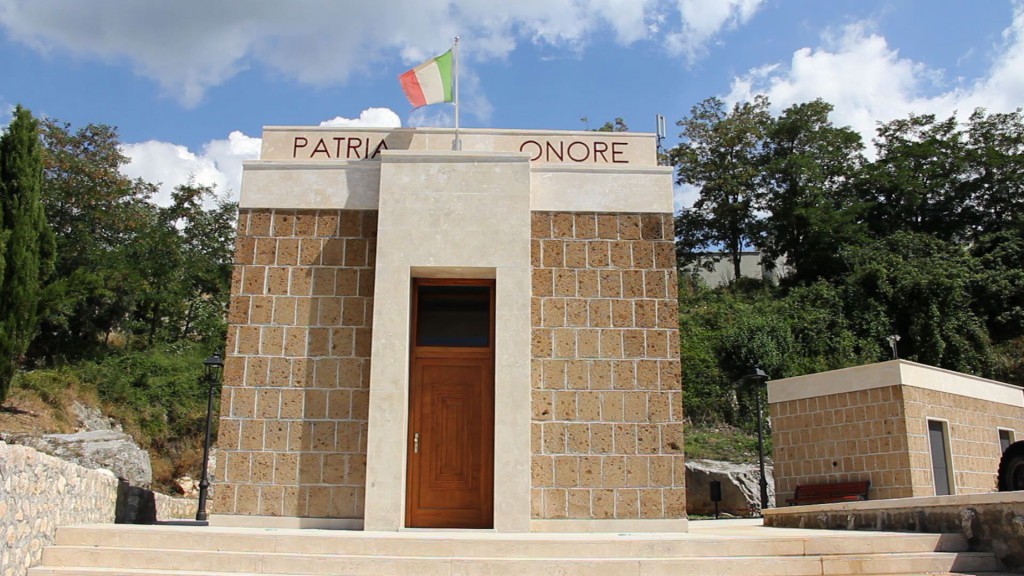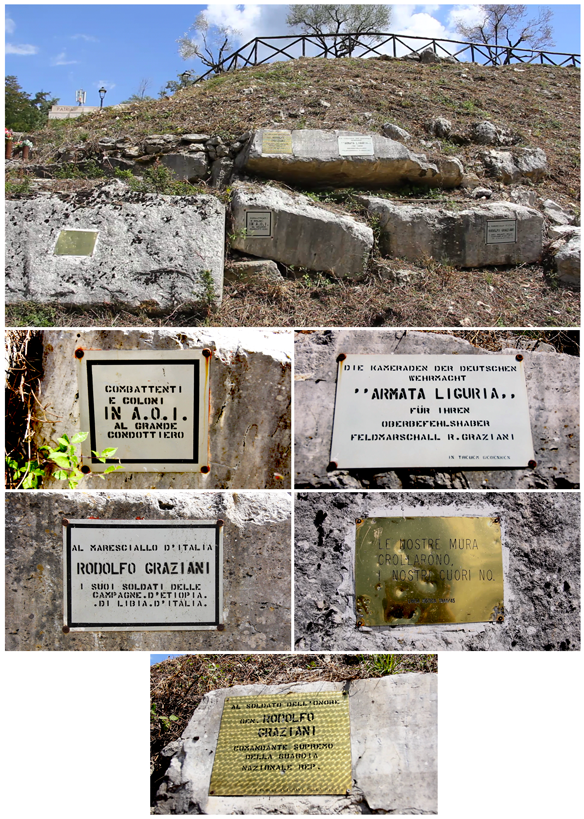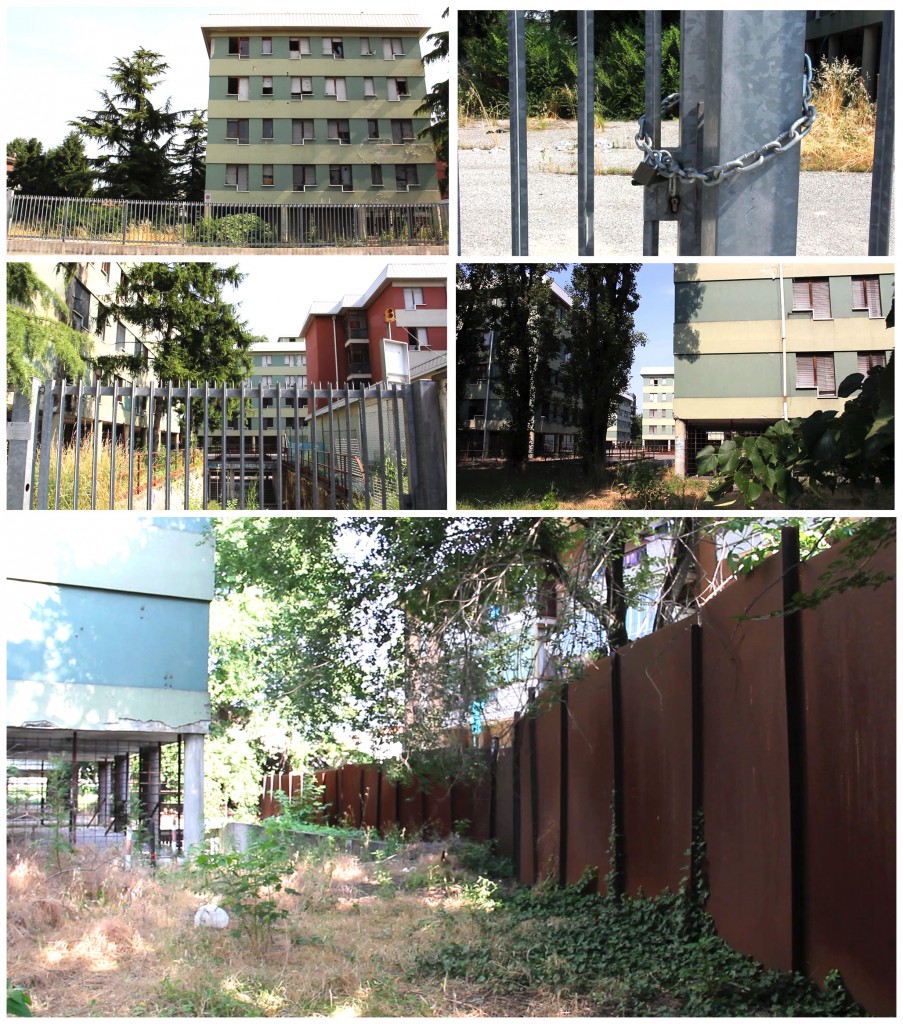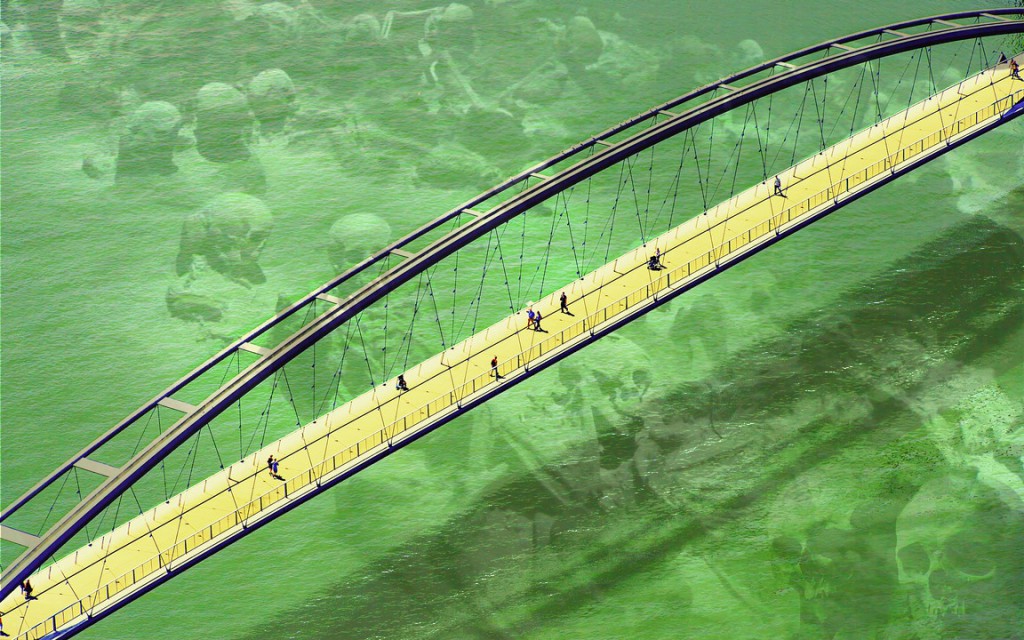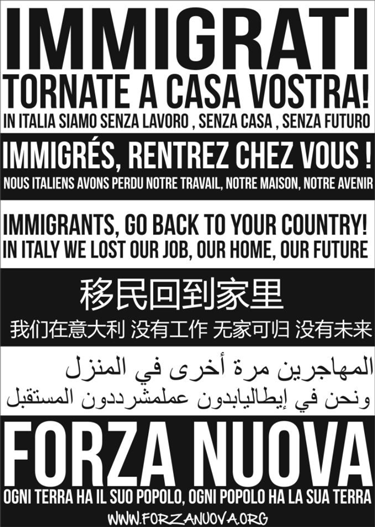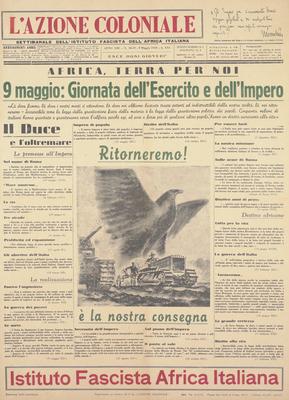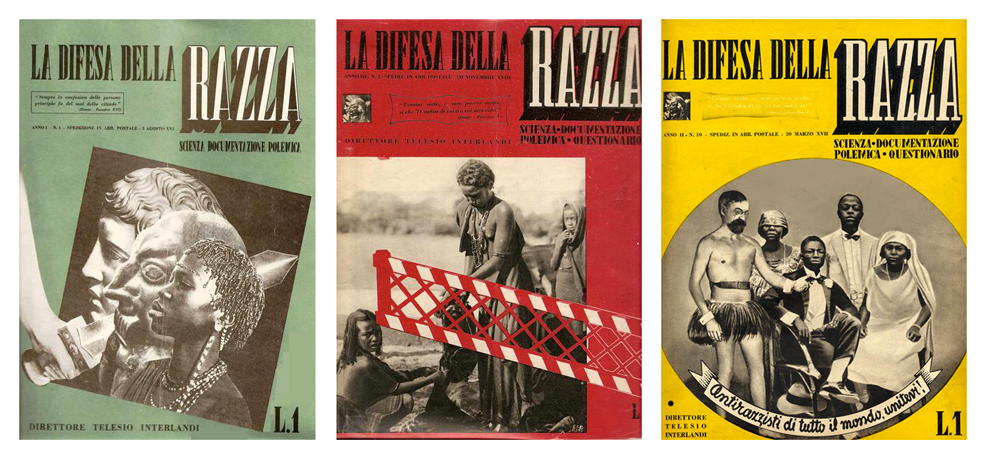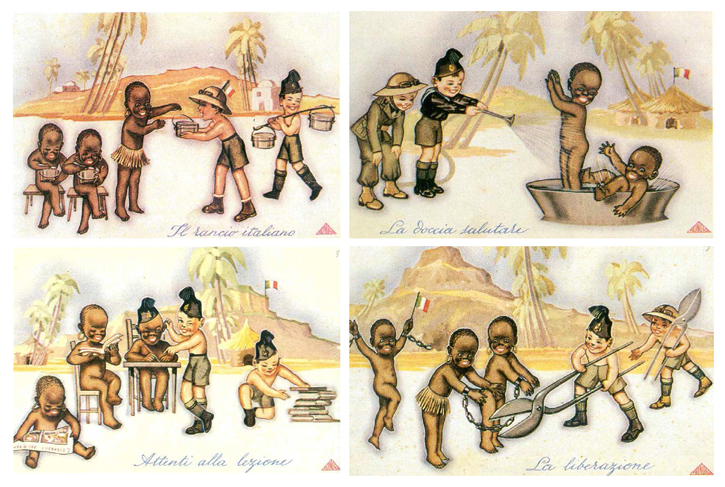The “meschina Italietta”[1] has a history of violence, oppression, exploitation, killing, expropriation that for too long has been removed from our books, from our memory.
Which history? Our history!
Every time I talk about colonialism with friends, relatives, acquaintances or people I met by chance, almost everyone seems to minimize the extent of our oppressive imperialist intervention in the former colonies.
The rhetoric of the “short duration”, “lacking economic productivity”, “limited geographical extension”, has been masked for more than a century as “colonialismo buono”, that means a “good colonialism,” and the Italian colonialists as “brava gente,[2]” “good-natured people”.
As if colonialism could be in any way justified because of inferior range compared to other Europeans countries! In the guilty conscience of many is still the case.
People recall to the time when Italians were there to build bridges, roads, schools, and churches as if they were “civil” and “good” works done to “modernize” the countries and “help” local communities. These works were made because the occupations were both of settlement and of exploitation and so it served for the wealth of the colonizers and a greater benefit for the motherland. With the construction of roads and bridges for example, the transport of material was facilitated and the time needed shortened. Moreover it was possible to have a more extended control on a broken ground, difficult to be accessed by the military vehicles. The churches were built to give spaces to the missionaries to carry on their work of evangelization and “civilization” of the populations considered “wild” and deprived of human values. The schools, first and foremost built for the education of the colonizers children, were places of indoctrination where it was imposed the superiority of western knowledge, both through the imposed language and through the subjects taught. The cultural heritage of local communities was concealed.
Ever the schools were religious one, where the need was to wipe out who these children were to make them who they wanted them to be.The circles of culture, which in the time of fascism became fascist headquarters, were places where only whites Italians could have access. Nonetheless some black native people were “welcomed” either as attendants, colonial soldiers, or in some cases lords of local “elite” who had been hired paternalistically in local power positions within the community to have a direct control over the population. These last were also who to then pass on the colonial heritage of command, as coadjutor in the administrative and military colonial apparatus. This was done to pursue even after the process of decolonization, a patriarchal culture of violence taught by the “settler’s fathers”.
Colonialism has a long history and its beginning lead back to the conquest of America, initiated by Christopher Columbus (Italian: Cristoforo Colombo) justified and quickly officialised by the papal bull “Inter caetera Divinae” promulgate by the then-pope Alessandro VI Borgia who in 1443 granted the Spanish reign with the domination on the new western territories. In the bull it is written: “The form used for this act was the usual medieval guarantee based on the fullness of the apostolic power of the Pope, and the possession of the discovered lands required the usual condition of the obligation to introduce the Christian religion in the occupied lands.”[3]
To remember is also the “Romanus Pontifex” Papal Bull issued by Pope Nicholas V in 1454 which recognize to the Portuguese crown the conquests made on the African territories, in particular in Morocco (Ceuta, 1415) and along the coast of the Gulf of Guinea. In the Bull is even recognized the slavery of blacks in Africa subjected to the Portuguese colonizers either as a result of the occupation or under commercial purchase.[4]
This is pointing out to an indissoluble bond that exists between law, money, religion and politics.
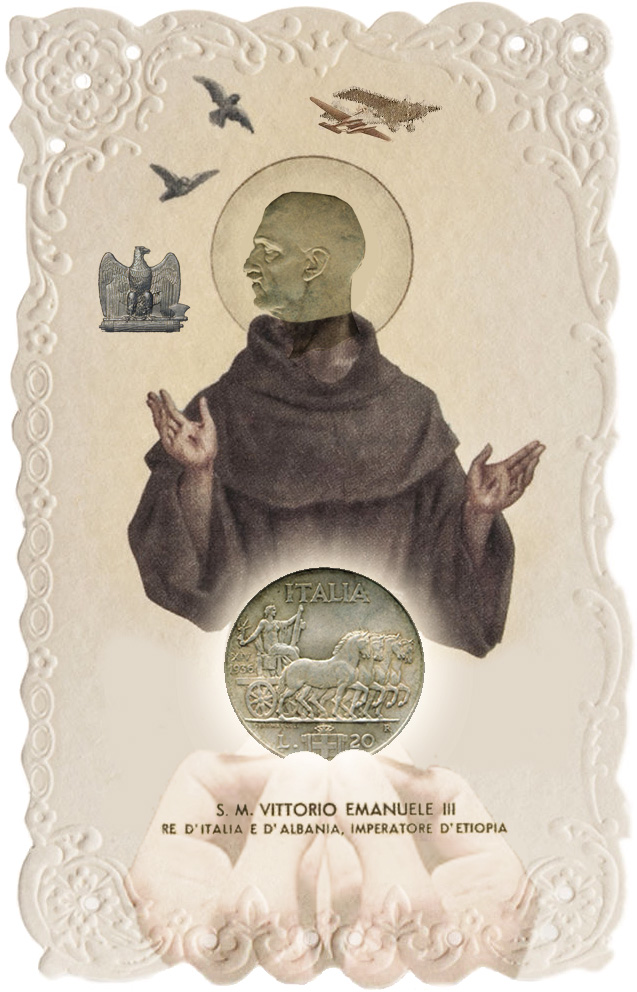
Photo Collage 2013, L’ostia dei popoli (The people’s holy bread)
The collage includes different elements such as the Eagle fascist symbol, the 20L. Empire coin (forged in 1936 to honour the Italian Fascist Colonialist Empire right after the occupation of Ethiopia), the plane of a colonial postcard stamp and a St. Francesco holy picture.
Antar Marincola: “Once established in Rome, the Catholic Church needed to expand throughout the world. Colonialism was a vessel. Figures such as the religious missionary, the soldier and the explorer, were the ones who went to conquest the world. I believe that the Church did what any other power apparatus would do. It was to colonise a world and it was also to evangelize a world.
So boxes with weapons and other things would arrive, as well as boxes with bibles and gospels, and in some boats there could be a priest; two priests…
To stay out from world current affairs is not possible by the church; the church has always inhabited the world, it does it now and it will always do.
Today we have an Argentinian pope, a significant messenger of Jesuits during the Videla military dictatorship in the Dirty War from ‘76 until ‘83. He had a significant role in the junta when many people disappeared, many priests were killed too, and he hasn’t told us anything about that so far. So where does the church stand when it’s a question of power? The church stands by the power, it will always stand by the power. The power of colonialism was a relevant one, it has labelled an age, centuries. The church stands by power, the church is a power.”
The scramble for Africa took place between 1876 and 1884, when the European powers, driven by the interests of imperialism, began to devote their attention to the African continent. The industrial expansion required raw materials to elicit and new markets where to sell the products of the industry.
The Europeans were already present in Africa before the nineteenth century because of commercial reasons. The coasts were used for the “slave trade” and to facilitate travel to India but the early explorations of the interior of the continent occurred only after 1815. Mainly missionaries of various churches who had the task of civilizing the “barbarians” people of Africa carried these out. At this point two were the crucial events that changed radically the relation between Europe and Africa.
First was the “Geographical Conference of Brussels”, organized by King Leopold II of Belgium in 1876, which lay the ideological foundations of the conquest of the African continent, used then by all European powers to justify their “imperialist” enterprises.
Then there was the international “Berlin Conference”, commissioned by the German Chancellor Bismarck and France, where Britain, France, Germany, Belgium, Netherlands, Italy, Spain, Portugal, Austria-Hungary, Denmark, Sweden, Russia, Turkey and the United States took part to regulate the navigation and the commerce along the rivers Congo and Niger, but in fact the real goal was to give to white peoples overseas, the European powers, the right to sovereignty over the African continent. For this reason the Congress conventionally marks the start of the scramble for Africa.
Most of the boundaries that exist today in the former colonies are artificial creations of Western hegemony. What impact has their definition on the current political situation of these countries?
Antar Marincola: “It is clear that these borders arose within colonialism, and it’s true that once they are in place one can grow fond of them and one does not question them. And why? Because to ‘trespass’ is far more complex.
For one to ‘trespass’ it means to undergo a challenge, and so to expose oneself when you have power is one thing, but having to question the borders that have been instrumental to Western colonialism, means to rethink what it meant to Africa before colonialism and after colonialism.
This issue is very complicated. So, what did they do in Somalia? They left the borders where they were because they thought “There are already 4 or 5 different languages and religions; and if we were to eliminate the borders there would be even more confusion”. The confusion becomes the most interesting element concerning the discourse on openness, but certainly for a disciplinary and power discourse it becomes the element they must always fight.”
It is clear that the “explorations” were not merely done by European governments for scientific and humanitarian purposes but that these aggressions were driven by political and economic interests.
After few years of its formation, the unified Italy started soon to have expansionist goals.
Italian colonialism had two faces, one during the liberal period (1882-1921) and the other during the fascist one (1923-1943). In 1869 the Lazarist father Giuseppe Sapeto purchases on behalf of the Genoa shipping company Rubattino the Bay of Assab (Eritrea) from the local sultans. This is the first Italian outpost in Africa. After some years, in 1882, the Italian state buys from Rubattino the rights on Assab, which is officially proclaimed Italian colony.
The most substantial Italian colonies were Eritrea (1882-1947), Tien-tsin in Cina (1902-1947), Italian Somalia (1889-1908), Libya (1911-1943), Catelorizzo, Rodi and the Dodecanese islands (1912-1943), the Saseno islands and Capo Linguetta in Albania (1920-1943), Italian Ethiopia (1936-1941) and Albania (1939-1943). In addition, we shall remember the occupation of Slovenia and Croatia (1941-1943).
[1] Meschina means miserable, Italietta is a diminutive used in general to describe the naive, irresponsible, shallow part of the Italian population. I found this expression in the poetry Alla patria of the partisan Giorgio Caproni “Laida e meschina Italietta. Aspetta quello che ti aspetta.Laida e furbastra Italietta.”
[2] Angelo del Boca, Italiani brava gente? Vicenza, Neri Pozza, 2005
[3] My translation from http://www.atuttascuola.it/contributi/storia/La_bolla_Inter_Caetera.pdf
[4] For more information on the Papal Bulls http://www.sguardosulmedioevo.org/2012/04/la-bolla-romanus-pontifex.html
A) RELATION BETWEEN CAPITALISM AND COLONIALISM
From the very beginning the motive of the colonial expansion policies is that of capital accumulation that leads Italians in no time in taking possession of the land, resources and people of these territories. The genesis of the capitalist economic system that is the system of over-production, exploitation, environmental destruction, and impoverishment of the many and the enrichment of the few, privatization of primary resources, land, bodies and minds, is to be found right in colonialism. Today, as in the past, in the name of super-profits for companies and governments continues the super-exploitation of the workforce of the former colonies.
The dominant state controls the economy of the subjected state according to its interests (use of cheap labor, opening up new markets to sell goods produced in the mother country, use of raw materials, etc.). This economic relationship it is an unequal one because it creates a total dependence of the subjected countries toward the imperialist states.
B) PATRIARCHAL HEGEMONY OF WHITE MAN IN THE COLONIES
During the colonial campaign sexual racialised policies were at the core. The woman has been used as symbol of conquest of the land, depicted as “fertile, available, wild and passive”. It raises the myth of the “Black Venus”.
The practice of Madamato, that means the “rent” of a woman, a “household-wife” for a specified time, was used without legal constraints, it did not constitute for the Italians, once back in Italy, nor bond nor problem.
This “ero-exotic” vision of the black woman has been with the time substitute, especially during the advent of the racial laws in 1938 during fascism, with an image of the woman ugly and deformed, for the need to show their invented constructed inferiority. Bodies were commodified, women used as objects in colonial exhibition. The racist song Faccetta nera was even prohibited because it suggested promiscuous relations with native women. The fight against mestizo couple brought in 1939 to the crime of “injury to the prestige of the race”. Anyhow, despite the fact that brothels with white women were introduced in the colonies, sexual relationships between native women and soldiers were rather frequent.
For Antar to intervene in this context it was to speak about the experience of her grandmother Aschirò Hassan and her mother Timira Marincola.
Antar Marincola “the Madamato is the result of racial laws when the white Italian man could not legally have a black woman at his side, so she had to be (literally) defined as “Madame”: a temporary woman.
Indeed the verb “to colonise” means to hunt, to take possession of. As it is with language too, it’s the idea that it can often be said, “to ‘own’ a woman”.
There is no coincidence that in warfare there is always rape; there is always the idea to treat the women as the war or country of war itself. If you annihilate the women in a place of conquest, you have annihilated the place itself, as she is the one who gives life.
Let’s assume that in Africa the woman is black and thus is considered by the western perspective more closely related to animals than humans, or is in fact an actual animal.
Therefore, colonisation and possession becomes one and the same thing. This is the true manifestation of colonisation.”
The position of the woman during the colonial time and today it is a central topic for Igiaba, who among other texts, in her doctorate research/thesis focus on three Italian-speaking woman of the Horn of Africa.
Igiaba Scego: “In the colony some women didn’t meet the Italians because they were hiding, many other unfortunately did interacted instead. I also think that there were some real love stories – I don’t want to neglect this possibility – at least I hope there was, but for most of the women who were still tied to Italians, however were then abandoned with two or three children. Once these men ended their period in the colony, they would return to home, leaving these offspring and women at the absolute mercy of it all. They were the infamous ‘Madames’, so it was said during Italian colonialism. Then there were the rapes, during the wars or whilst rounding up the villages.”
How can racialised sexism take shape in contemporary society?
Igiaba Scego: “I have many friends who are Italian actresses, daughters of immigrants, that when they look for a part for a movie they are asked to be either prostitutes or caretakers, usually more frequently prostitutes then caretakers.
So we also have a quite distorted way of looking at reality. We never talk about a black woman, a daughter of immigrants, who is a student, a journalist, etc. There are these figures in reality but it is always preferred to tell the same story.”
In which conditions were obliged to live those children born from “mestizo” relations?
Antar Marincola: “In Somalia, as is the case of most colonised countries, children were actually ‘spawned by sin’ because they were born through illegitimate relationships. In that area, such a chauvinist concept was rather a predatory one for which women were not women, and the children were therefore not sons, so the latter remained literally abandoned.
In Somalia there was a religious order, the “Sisters of Consolata”, who took care of these ‘bastards’, both male and female.
What did these children do? Here the children remained, growing up in orphanages were they were not recognised; the father did not recognise them, neither did the Somali communities, believing that they were bastards. The majority of these poor kids lived a frightening environment because they were not Somalis or Italian, growing up as stateless people in a territory. They were symbols of the combination of the white coloniser and the black colonised, resulting in a reality that they did not chose, but of which they were subjected to all consequences.”
C) THE USE OF PROPAGANDA THROUGH THE MEDIA
Which has been the role of populist colonialist media propaganda, liberal first fascist then, in the creation of a racist collective imaginary of the colony among the officials, the colonists and the folk in Italy? How was it display? Which tools have been used?
The pounding use of propaganda during the colonial time, liberal first fascist then, through the use of media of the time (newspaper, photography, postcards, illustrations, radio, songs and films) has been perpetuated to create a collective racist imaginary toward the former colonies inhabitants, depicted as inferior and barbarous; to reinforce a sense of superiority of the “Italian race” and belonging to the nation; to justify an African venture of pure aggression masked by the concept that the Italians went to Africa to “modernize” a backward country, bringing culture and civilization, and by doing this completely denying the identity of the natives, the language, the culture, rituals and traditions, the social model.
The masters has absolute power over the colonizers, they possess their rights on life and death.
Among the newspaper we can mention L’Azione Coloniale[i] , Il popolo d’Italia, Corriere della sera, La difesa della Razza[ii], Lettura, La Domenica del Corriere[iii], L’Oltremare[iv]. The most popular postcards are from Enrico De Seta[v], E.Ligrano, Giovanni Bonora[vi]; pictures from Luigi Naretti, Lidio Cipriani, Alessandro Lessona; Illustrations from Galba[vii], Gioacchino Colizzi; among the songs Tripoli bel suol d’amore, Africanella,Ti saluto, Vado in Abissinia, Faccetta nera, In Africa si va, Adua, Il canto dei volontari, Il ritorno del legionario. [ [i] , [ii], [iii], [iv]. [vi]; [vii] to be find at the end of the page].
The concepts inculcated to the Italians are a haunting propaganda that allows today to a denial and a rejection of historical truths that results to be too inconvenient to face as for Italy’s reputation.
Igiaba Scego: “I have an obsession with fascist songs lately. I’ve heard a lot of them because they are very, very interesting. There is the famous “Faccetta Nera”, “Pupetta Nera”, and “Africanina”. The latter should be listened to because it says “you will get to know how to kiss the garibaldiana way”, “I will teach you this and much more” and then at the end of the song it says that women should give birth to children who had to be called “Balilla” (the name given to the fascist youth). Another song is “Ziki Paki Ziki Pu” where a woman hides behind a tree, she has sex with an Italian man and then he leaves her because she is fat. If one goes to the local market today – I often go to Porta Portese and every time the various men of the market make fun of me because I ask for fascist photos, I don’t care and ask them anyway as I’m interested in this because of my studies – there you find a lot of pictures of naked women. The gaze of these women always struck me, because it was as if they knew they were in front of a camera, they were naked, they were the goods of the person who was photographing them. However they did not lower their gaze. I read in their looks a slight challenge, as opposed to what they were subjected to. These are very interesting photos, terrible but interesting because they make us understand what Italians believed they could do in the colony. This was commercially a very big business; photos of women were everywhere. At some point Mussolini started to dislike this fad, so “Faccetta Nera” became prohibited by fascism because it promoted interracial marriage in a time when Italy was approaching Nazism and the racial laws of 1938.”
D) DETENTION CAMPS IN THE COLONIES
Was quite astonished for the Italians in the motherland and especially for the soldiers in the colony when those “weak barbarians” successfully defended their land and civilians causing two clamorous Italian defeats the first in Dogali ( Eritrea-1887) and the other, the most known, in Adwa (Ethiopia-1896).
If this slow down for some years the colonial ambitions in the Horn of Africa, soon with a revanchist upswing, when the Giolitti government conquered Libya (1911), Italy gain an image of “pride”. The brutalities increased exponentially with the takeover of fascism. Mussolini conducted a real extermination campaign starting from the Libyan territories (Cyrenaica and Tripolitania) up to the invasion of Ethiopia (1935) and the consequently declaration of the birth of the Italian Empire (1936).
Battles were won above all because of the superiority in weapons, means and other deadly technologies. The “altruistic” and “good” Italians, during Mussolini´s dictatorship, have racked up ferocious massacres: execution of unarmed peoples, destruction of fields and cattle, fires and looting in villages, rapes of women also collective (women were left naked for days with hands and feet tied to tables or hold still by their own families and then raped repeatedly during the day), shooting, hanging, beheading (sometimes the heads of the natives were stuck on poles and carried on the soldier trucks around the villages as a punishment demonstration for all) various tortures, extermination of rebels and resistants, as well as storytellers, soothsayers, etc.
Moreover we should remember something that it has been totally neglected from institutionalized history, the existence in the colony of detention camps[1], with which Ottolenghi refers in his book to “all those places in which are hold, for whatever reason, people against their will: they include, concentration camps, punishment camp, rehabilitation camp, extermination camp, prisoners of war camp, internal exile camp, internment camp, labor (forced or not) camp, isolation camp, etc.”[2]. The reasons for the establishment of these camps were many, dictated by the need to have isolated places, easily controllable, where to bring together different “sort of individuals” (rebels, prisoners, youth, soldiers), on which it was needed to exercise a certain type of surveillance, either preventive or repressive.
In addition to these we can add another type of camp, defined camp of confinement, reserved for the natives soldiers, called Ascari, Zaptiè or Dubats (black colonial troops), which together with the Italians colonial, guarded the colonial borders.
Mussolini showed off, in public discourse, contempt for the enemy and emanated directives against contamination. The racial politics of fascism in Ethiopia anticipated the South Africa apartheid introduced a decade later. Segregation was sanctioned by the racial laws of 1938: promiscuity was banned on public transport, it was banned for owners of vehicles to employ black drivers, areas were reserved in cinemas for natives’ film, doors in offices were separated, etc.
[1] A list of camps in the former colonies can be found on: http://www.campifascisti.it/elenco_campi.php
[2] Gustavo Ottolenghi, The Italians and colonialism. The Italian detention camps in Africa, SugarCo, 1997.
E) COLONIAL HISTORICAL DENIAL AFTER THE WWII
The historical removal has gone hand by hand with the act to censure, misinform or not inform at all. State archives are closed or difficult to access. The former Colonial museum, then called the African museum, created in 1923 and managed at the time by the Ministry of Italian Africa, was closed in 1972. Beside all the problematic that can have an anthropological museum, as the many in Europe that have a racist hegemonic point of view, if critically used could be an important source for research. As well the Italian Institute for Africa and the East, a public body lately in charge to manage the African museum, again a place where to research on Italian colonialism, was closed in 2012 because of financial problems.
Another symbolically repressive act to disperse memories has been done with the censorship (30 years circa) of the movie The Lion of the Desert (1981) of the Syrian-American filmmaker Mustafà Akkad, which tells the Libyan story of the anti-colonialist resistant Omar el-Muktar, from the Arab point of view. In the words of the then Prime Minister, Giulio Andreotti, the film “harms the honor of the army”. It is not possible to find a copy of the movie with Italian subtitles or dubbed. Even to get one in English I had to approach an international online shop.
Furthermore the documentary Fascist Legacy, produced by the BBC, on the fascist crimes was purchased by the Italian State Television and never aired.
In June 2009, during his first official visit to Italy, Muammar Ghedaffi kept pinned on his chest the historic photos of the arrest by the Italian colonial troops of the Libyan resistance el-Muktar and stepped accompany, at the meeting with the Italian institutions, by el-Muktar son. The Italian Army killed Ghedaffi paternal grandfather, Abdessalam Bouminyar, during the Italian invasion of 1911. On that occasion, the Sky television platform, announced the screening of the film The Lion of the Desert on the day after the visit of the general. Nevertheless, the event has not attracted any kind of debate at the national level.
In recent years, Italy is crossed by new nationalist and patriotic waves that reinforce strongly the opposition to “international terrorism” and “illegal immigration”.
Symbolic places of “patriotism” were rehabilitated, an example of all is the Vittoriano also called Altare della Patria, reopened to the public after 31 years, in November 2000. Its name comes from Vittorio Emanuele II of Savoy, the first King of Italy, to who the monument is dedicated.
In 2004 was inaugurated at the Vittoriano museum the exhibition entitled as the brochure says: “The Epic of the Eritrean Ascari. Eritreans volunteers in the Italian Armed Forces from 1889 to 1941”. In the description they write that the initiative “is intended as an act of homage to the immense contribution of courage, loyalty and blood bore by Eritreans – in accordance with their age-old warrior traditions – to our armed forces during the period of the Italian presence in Africa (1869-1941)”.
The above statements are taken from the dépliant of the exhibition:
This exhibition has exalted the nostalgic memory for an imperial past that in no description has taken the name of colonialism, conquest, exploitation, repression or fascism. The Ascari black soldiers are represented as faithful servants of the country, in their words, as “volunteers”, omitting the reasons why they enlisted, the discriminations to which they were subjected to, the miserable conditions in which they were forced to work, all this by brutally simplifying their role.
In addition “beyond the ‘warrior traditions’ attributed to the Eritrean population, which reflects one of the most stainless prejudices of colonial Italy, it is symptomatic the aseptic enunciation ‘Italian presence in Africa’ to characterize the ‘normality’ of the page’ colonial Italy therein including the fascist occupation of Ethiopia of 1935-41[1]. ”
[1] Mussolini announced the occupation of Ethiopia on the 9th May 1936 from Palazzo Venezia. In his speech he claimed “(…) today, May 9, on the fourteenth year of the fascist era. (…) Italy has finally its Empire today. (…)”. A video of the announcement can be seen at: http://camera.archivioluce.com/camera-storico/scheda/video/i_presidenti/00025/IL3000052643/1/5maggio-XIV-L-adunata-9-maggio-XIV-L-impero.html
F) THE CASE OF RODOLFO GRAZIANI MEMORIAL
In many Italian cities, streets, squares, theatres, cinemas recall our colonial past without any kind of contextualization. Brutal generals are still celebrated as the saviors of the country.
Monuments are built to rehabilitate fascism in public memory. In August 2012, a monument in memory of Rodolfo Graziani has been inaugurated in Affile, in the province of Rome. Graziani, Benito Mussolini’s military commander, also called the “Executioner of Libya” or “the Butcher of Ethiopia” is the fascist General author of the ruthless repression of the anti-colonial revolt and who decided, among other atrocities, to bomb Red Cross hospitals and to sprinkle mustard gas on the unarmed Ethiopia populations, going against the Geneva Convention, causing the death of thousands of people and the destruction of lands. In 1950 he was sentenced to 19 years, of which he served just four months.
In the Affile town hall’s web site Graziani is listed in the “Famous people of Affile” page[1]. In the article to him dedicated, clearly devoted to commemorate the “good” fellow citizen, is written that “Graziani was able to direct his every act for the good of the homeland through the inflexible moral rigor and meticulous fidelity to duty as a soldier that distinguished him from belonging to the ranks of ignoble or to the large category of the many who only pursued the logic of self-interest.”
As to say if you obey to the nation everything is allowed, even to kill thousands of people.
It’s not by chance that on the top of the mausoleum is written “Patria e onore”, e.g. “Homeland and pride”.
Picture of Rodolfo Graziani Memorial taken in Affile in August 2013
Many Affile citizens are fascist nostalgic. It occurred again this summer when an event was organized, on the 29th of June in honor of Graziani, by the association named after him. “Manipulars[2]” of one hundred people, including the major Ercole Viri (re-confirmed as major after the election campaign on May 2013 with votes up to the 62% of the population of Affile), took part in the conference organized in Afille entitled “Our countryman”. At their arrival Roman greetings (Saluti romani) have been performed in front of the mausoleum. Nothing is missing: guests, dinner and a closing party at Radimonte (the public park that is hosting the fascist mausoleum).
Igiaba Scego: “It is a monument that attracts fascists, neo-Nazis and neo-fascists like a magnet. I’m talking to you now, but in fact today on the 29th June, there is a gathering in Affile where Rodolfo Graziani is practically commemorated and celebrated. This means that there is a very precise project by the city mayor – a mayor alas, that has won back the election, even with a large majority, more than 60% – to transform this area into a Predappio (Mussolini’s hometown), a Predappio of Lazio, a city that’s maybe even worse than Predappio itself because the most grimy and cruel fascism is celebrated there. And let’s not forget that Graziani was also a member of the Salò Republic (a puppet state of Nazi Germany).
Personally, like many others I felt outraged and from the first hour, when on the 12th August when I heard the news, I started to send e-mails all over the world but I was not alone.
The thing that struck me was that before becoming an topic of discussion in Italy, the first article that came out on the Affile issue was in “The New York Times”, so not a neighbourhood newspaper or local newspaper, while our “Repubblica”, “Corriere Della Sera” (both national newspapers) were enjoying their holidays.
I found this very, very serious and those who rallied the matter – the ones I call ‘the usuals’ and thank god that there are ‘the usual’ – like the Anpi (the national association of the Italian partisans) and people such as Giacometta Limentani who is a Jewish writer from Rome; Alessandro Portelli and many others; Alessandro Triulzi; historians; especially historians and intellectuals; writers such as Maaza Mengiste; myself… Groups of indignant people all of who absolutely want to do something about it.
In addition, to this unified group, a local group constituted by young people who have labelled themselves as “Affile anti-fascist committee” are trying to fight not only against the monument but in particular against the mentality that is in construed within monument.
Personally, I have also made a petition against the monument, which went very well; people from all over the world helped me. I managed to involve Amitav Ghosh who is one of the greatest living Indian writers. In short, thanks to him, many people from the United States have signed the petition. Unfortunately, the monument is still there and I think that there are no other solutions, it should be torn down or seriously modified. The problem is how can we change such a monument that is stained by this story?”
During this summer I contacted the Anti-fascist Committee in Affile, made up of seven people, which was created after the inauguration of the memorial as before that moment it was hidden to the public the reason why that building was constructed. The reason why I contact them was because I wanted to make a public site specific intervention on the memorial, to continue to critically cast light on it, by showing on the walls of the building the film The Lion of the desert, to recall the attention on the censured film that stages the “butcher Graziani” as one of the main actor.
The answer I got has been quite worrisome. Just one week before two journalists from New York, have come to Affile with the intention of making some footage of the memorial and some interviews, including the Committee and the mayor, with the ultimate goal of making a documentary about the new dawn that Fascism is frighteningly having nowadays (CasaPound, Forza Nuova, and many others) in Italy.
Well, at the sight of these two “foreigners” complete with cameras, one of the memorial “sympathizers” has pouncing with absurd and deranged violence one Committee comrade and afterword the two journalists breaking even the equipment.
The motivation? “You busted our balls by letting foreigners come in Affile”.
This e-mail was clearly describing the “strategy of tension” that endures in Affile, a village of 1500 inhabitants, especially since it caught so many outsiders’ attention.
After received their answer my first thought was to meet the people from the committee – in a more neutral space – in order to have a direct genealogy on what happened and on the actual state of things. So that at the end of August I took an appointment in Rome with one of the guy of the committee, who gave me his insight on the situation and many information which are not accessible from the media. He also encouraged me going to Affile and assured a guided tour at the memorial with others of the committee.
So after few days I found myself in Affile. Three other committee members were there to wait for me and a friend of mine. After a small talk we took the road to the memorial. It is a steep street the one that bring to it so we went by feet. At the road cross before the hill a Carabinieri car was parked to make a checkpoint. The committee people approached them to advise that they were bringing us to make some shootings at the memorial to make them aware that if something would happen again they would be in part responsible as witnesses! Our visit at the memorial was quite short, the last experience caused a kind of a trauma and from time to time the gaze was turn to the street to see if some provocateurs would reach us.
Before to get in front of the memorial, on the right side, on some rocks were affixed five plates to the memory of Graziani such as (from the first picture left):
– Soldiers and colonists in A.O.I. (Eastern Italian Africa). To the great warlord.[3]
– The comrades of the German Wehrmacht “Armata Liguria” for theirs supreme commander field marshal R.Graziani.[4]
– To the Marshal of Italy Rodolfo Graziani. His campaigns soldiers. Of Ethiopia. Of Libya. Of Italy.[5]
– Our walls collapse. Not our hearts (Gothic Line 1944/45).[6]
– To the soldier of honor General Rodolfo Graziani. Supreme commander of the Republican National Guard.[7]
Picture of Rodolfo Graziani plates taken in Affile in August 2013.
On the 22sd of July 2013 Nicola Zingaretti in a written answer to the interrogation presented by the regional councilor Giancarlo Righini (from the right party Fratelli d’Italia created in 2012 from politicians beforehand belonging to the Popolo della Libertà, Berlusconi’s party) said that the project of the memorial and of the park and their realization have been regular done so that if they would eliminate any reference to Rodolfo Graziani the financial aid will be given again to the municipal committee. So that the bust and other relics of Rodolfo Graziani which where situated in the small museum created inside the monument, were suddenly removed! What a trick!
What will it change once the name of Graziani disappears from the public eye?
Wouldn’t that still be a place where fascist nostalgic meet to commemorate the fascist colonial legacy on the 29th of June again and again?
What will change if after many months the school head of several schools, in Affile and in the neighborhood cities, don’t give any sign, any answer, to the proposal of the Antifascist Committee and the local A.N.P.I. (Italy Partisans National Association) to bring in the schools a program where to research on fascism and colonialism?
The story of Affile is paradigmatic of a more complex system of oppression and fascisation of collective consciousness.
Shame on Italy! “Dismantle the memorial built for fascist Graziani!”
Beside all other different initiatives done to criticize the realization of the monument, its demolishment seems to be the most pragmatic way to deal with it both for the Affile’s Anti-fascist Committee and the Visionary Youth Group (Bale-Ra’ey). This latter in collaboration with Semayawi Party, promoted, in Addis Ababa (Ethiopia), on the 17th March 2013 a protest rally against Graziani mausoleum[8]. Under the video page, linked in the previous footnote, it is written: “the rally was dispersed after the current fascist regime in Ethiopia arrested more than 40 of the organizers.” Could this be a manifestation of how fascism and colonialism continue to co-exist?
Why the perpetrators of massacres, torture, and atrocities committed in the colony were not pursued but even celebrated as heroes?
As Igiaba Scego says in her doctoral thesis[9]: “Often happens that the voice that keep heard over the centuries is the one of the rulers and not that of the dominated, the latter is suppressed, repressed, deleted. The dominated, the subaltern, has no place in the annals, in the official history, in the monuments, in the legitimate memories. This is the basis of what has been called the colonial relationship. This type of relationship requires an insurmountable diversity in which the colonialist doesn’t hopes for that the colonized looks like him in practices, traditions, habits, words. The cultural diversity, as well as the physical one, is the fundamental ring used to justify the abuse of power, the domination.”
Last but not least, to give another hint of the intersection between the past and the present time in continuity with an authoritarian patriarchal neo-liberal power. On the web site http://www.rodolfograziani.it, managed by the Associazione Culturale Maresciallo d’Italia Rodolfo Graziani formed in Affile in memory to Rodolfo Graziani, to which also the major belongs, as last news it appears this:
Which translated is:
07/08/2013 – Invitation to Prime Minister Berlusconi
The mayor of Affile Ercole Viri, one of the founders of the Italian Marshal Rodolfo Graziani Cultural Association, invites the President Silvio Berlusconi to choose Affile as Municipality where to “serve” through the social service the absurd conviction.
The President would take care of the gardens of the park Radimonte, catalogue the relics of the Soldier’s Museum and to manage the organization of cultural events that will take place in the Park.
Affile is a country known for Cesanese, excellent DOC wine, the fresh air but above all as the village of the Italian Marshal Rodolfo Graziani, indomitable warrior like the Knight[10]. The Mayor agrees from now on to dedicate to the untamed leader Berlusconi any above extension of the Museum of the Soldier.
G) RACISM AS THE LOGIC OF COLONIALITY OF POWER
What is left today of the colonial past? Which repercussions does it has on the contemporary society?
It is clear that the actual political/social situation, in Italy as in the rest of West Europe, is connected tight to the past historical time. Racism, as colonialism, is integral part of the system of commodity production.
The dispossession and subjugation of people continues still today. While before they were promoted through the act of “civilizing the barbarian savage people” today, on the same hegemonic way, in a more or less subtle way, it is done by spreading values as “freedom”, “democracy” and “civil society”.
Exploitation continues on such a high rate that we can talk about modern slavery. The colonial past unfolds itself in the present time. As Paolo Jedlowski says “the form in which this memory has survived is especially racism. This prolongs the ideological assumptions that legitimized colonialism. Racial taxonomies and apartheid policies are protracted in representations, attitudes and rules proposed by the majority of today Italians against migrants. What the public memory does not process remains in a latent form in society (…). [11]
In this context I want to mention the history of the Via Anelli´s Wall.
The wall built in Anelli Street, in Padua, is a dispositive of control that was built by the City Council in 2006 to segregate the migrants’ community who was living in the housing complex call Serenissima. This latter was built in the Padua peripheral quarter called Stanga, in the mid-eighties, primarily as a residence for students, which were studying in the neighboring universities. It is formed of five apartment’s blocks, for a total of 280 flats. In the nineties, because of the speculation on the rents which price become more and more high, the complex depopulate of students and start to be rented by sex workers and migrants most of which seeking asylum, overcrowding it. In these years it appears still like a common housing block without any kind of fence. Very soon indeed the zone – in a time of increasing migration flows – started to be depicted as a symbol of “decay” from a racialising prospective: neighbored, city council, politicians and media.
The first maneuver of control is into action when an iron fence, about a meter and a half high, is placed around the complex. Soon the entrances are diminished in the number and in the size. In 2006 an iron wall four meters high is erected in order to isolate the complex Serenissima from the adjacent inhabited quarter of Via Padovani. This was done by the administration with the aim to contrast “unusual drug passages”. So, in this perspective the municipality of Padua starts a “security campaign” to lure popular consensus in anticipation of the political election. The criminalization especially of black people is at the peak.
Surveillance technologies are widely distributed on the territory and in the enclosed Serenissima four beamers that spotlight floodlit the central square all night long.
Over the course of one year all blocks have been closed down. The area since then has been left abandoned and as the media did not have any reason to mention this story anymore – the spectacle ended – the racist logic behind the Wall stopped to be questioned.
Pictures of the abounded Serenissima housing complex taken in Padova on August 2013.
It is very likely among white Italians to hear jokes, phrases, accents, expressions manifesting a continuous racist background noise. It is absorbed at school, in the family, at the playground, on the street, at the supermarket, on the bus. It is so well absorbed that also those that claim to be anti-racist in some cases get accustomed to it and in others they think that at the end is not a bad joke, that they are not perpetuating racism.
How does propaganda in contemporary society contribute to spread xenophobia and prejudices on the migrant as the dominant ideology within the democratic system, functional to the political/economic order (migrant seen, according to the need of the States and the global economy, as a resource, threat or victim in the name of security, welfare and national identity)?
How is it perpetuated racism through media such television, internet, newspaper, advertisement, etc.?
Igiaba Scego: “I think that racism today in Italy is the result of colonialism. Unfortunately I see very precise colonial mechanisms that operate towards women, especially women, but also men, etc. There are keywords or key concepts that are taken from that past and applied in today’s world. It is no coincidence that two years ago two guys from Senegal were killed in Florence by a neo-fascist linked to a group called Casa Pound – at least he claimed to be tied to it, they said he was not, anyway we will never know the true story. He took a gun and killed two people and injured three, just because they were black. So that is precisely part of an ideology, a racist ideology that stems from the racial laws of ‘38 that targeted Jews and colonial subjects: partly Eritreans, Somalis, Libyans and Ethiopians.
In the book I’m writing I speak about a female figure and all the stereotypes imputed to her. When black women are talked about in Italy it is said that they are sensual, available, a “thing to be used”. There is an old book written in 1934 by Mitrano Sani, a writer of that period, in which it is said that Eno, a Somali woman, is a “thing that the white men use when he has carnal needs”. It is a very heavy sentence for a book of that time, but then I see the same logic repeated in erotic movies such as the one with Ines Pellegrini or Zeudi Araya, I see it in the 80s commercials like the Morositas one but also in more recent advertising.
In general the black body is considered a hyper-sexualized body, both female and male bodies. There was an advertisement for liquorice, I can’t remember the brand, that said: “After dinner don’t have a sleepless night. End your night with a black”. So there have always been these sly allusions… In another commercial, “Coloreria Italiana” (a product to dye textiles) there is a woman who puts her husband, a pallid and very pinched man, in the washing machine together with the “Coloreria Italiana” product and then it comes out a black, beautiful, hunky man.
Additionally, the body is seen as a metaphor of foodstuff, like chocolate, sensual and naked. For example you can find this in “Magnum” ice-cream commercials, I guess this is the brand, either chocolate or coffee, always something to eat. This makes me crazy. Even the Fiona May commercial where there are those two chocolate slices with white milk cream in the middle. In other words these are messages that convey something annoying, heavy, that when you look at them you say, why are they doing it again?”
Recently I found a creepy news on the web that tells that during the next fall it will be aired on Rai Uno, the public national channel, prime time The Mission, a “humanitarian” reality show where eight celebrities (such as among the others Emanuele Filiberto, a member of the House of Savoy and the only male-line grandson of Umberto II, the last King of Italy) will go, together with the operators of UNHCR, the UN agency for refugees, and the NGO Intersos in some of the many refugees camps around the world, especially in Africa.
VIPs will, official sources said[12], “give away a few days of light-heartedness to the local population.” I am shocked by this spectacle of despair, from this missionary tourism, from this humanitarian pornography. The refugees are instrumentalized, treated as exotic background of the “Mission”! Horrible!
Not to speak about the title “Mission” which brings us back to the corrupted “humanitarian” and “civilizing” values, used by the church during the colonial campaign.
How can we not speak about the perpetuation of coloniality today?
In what other forms continue to exist relations colonial like? Was and is it still the language as a cultural vehicle a tool of colonial hegemony?
Antar Marincola: “Colonial relationships still exist. But if they become mental conditions that allow you to become the colonized and to stay there believing that your condition is unchangeable, that is one’s own choice. I believe instead that despite the imposed colonial French language you can use the French to tell us about the Balieu, to speak about today’s France, which is much more about Marseille more than anything else. Today, France is a country that has no identity except what the people of Balieu tell us. There is no longer the western European coloniser; today it is fragile; it has many problems; for example, it can no longer address the issue of Cyprus. There’s no point in thinking that the British or the French still have relevant power in the world. In my opinion, in those areas, it is the Chinese who play a strong role. They are shifting the axis. It’s them who are putting at stake boundaries and limits. It is no longer Europe. Europe is in trouble domestically. If we want to be the victim, we are victims until the end of the world. But we are not only victims, we can also be the perpetrators we are especially good at this when dictators rule our countries. Therefore, I do believe in fact that it’s not an issue what people impose on you, the language they force you to study, but the way you make use of that language and how you can turn it around and make it an instrument of power.”
Is it possible to speak about “post”-colonialism? Was there ever a real end to colonialism? How important is the theory and academicazation of the discourse on colonialism in the West (e.g., the “post-colonial studies”) on the creation of a fictitious overcoming of colonialism itself? Is it not promoted, even in this way, a normalization of racism? What are the ‘positive’ forms of racism that are to find in Italian society inside and outside the institutions?
In what forms the debris left by colonialism and imperialism have not only left a cultural heritage, but continue to shape the lives of former colonized peoples and today’s migrants?
What is the current situation in the former Italian colonies, what changes have occurred since then? What are the major issues, risks, and what are the possibilities for a change?
Igiaba Scego: “Generally speaking the word “post” is always to be taken with a pinch of salt.
In regard to colonialism, I can tell you about Somalia, but we can think of many other examples, I think that the colonial system never actually ended. The same Italy is living in a colonial system, the same Italy has been colonised and is the coloniser at the same time. These are things one must also consider, maybe you are not colonised by a country, but you are colonised by a financial system, I think that what we are experiencing at this time it is a kind of colonialism, that is a financial system that is colonising our daily habits, our communal ways of living and sharing: that is the very foundation of civil society. What is happening in Greece is atrocious and what can we call it if not colonialism? If not colonialism of finance? So the word lends itself to many meanings, but also to many speculations.
If we refer back to the historical colonialism and to Somalia in particular, I think that Somalia never got out of a colonial system. Actually it went out officially became decolonized in ‘41 when Italy lost the colonies. However, between 1941 and 1950 there has been the British interregnum that was supposed to help Somalia bridging the decision to give it the independence or to give it the Trust Territory of a third country. So the United Nations decided to give it a trust territory. Clearly the Somali people didn’t appreciate it because they wanted their independence immediately, as it should have been.
But the heinous thing that has been done, and I think it was a mistake, has to have been to give this regency of ten years, from 1950 to 1960 to Italy, a country at random! But why? Italy is the country was colonising until yesterday, so how can Italy teach democracy?
Aside from that democracy cannot be taught, I always say this when I go into schools. It is similar to what we did in Afghanistan or Iraq, exporting democracy, when your own democracy hangs in the balance.
I was very impressed that it was not Benito Mussolini who was asking the Trust Territory – “the colonial adventure ends with a bang”, as it was said at the time –but the likes of De Gaspari, Togliatti, all of them from right to left, from the Christian Democracy to the Communist Party, they all agreed to go back to Somalia. So there was a colonial mentality deeply rooted that goes beyond just fascism. In fact, I always say do not look only at fascism because the history of colonialism begins with liberal Italy, it begins after the Unification of Italy. Somehow to have a colony was a way of saying “we are a nation”, an Italy that has never been and I do think it is even now.
During those ten years, those who were already settled there concluded their business.
In my opinion it did not help the Somali people and I say this because of what my father told me – he was part of that group of people who went to study in Italy; he took the exam in Somalia and then came to do some sort of internship in Italy. He said what they learned during that time was a lot of laws, institutions, jurisprudence, etc. The roots of this education was actually Christian democracy and politics and not even the more suitable Christian democracy, rather the worst because of the buying and selling of votes, wheeling and dealing, bribery, all those things that we know pretty well and so these things have been transported in Somalia just in the same way. I think that our democracy that lasted 9 years – Somalia has not voted for 44 years, the first and last vote was in the 60s – did not have the time to take off on its own, and this is troubling and very serious.
After this democratic parenthesis – which was full of mistakes but at least they were democratic – Somalia, having passed from one error to another, entered into the 20-year military dictatorship of Siad Barre, which was first a communist dictatorship – a communist so to say, the only communist things Siad Barre had were the military parades, the iconography, Mao, etc. – and then out of the blue, since he no longer had the alliance of the Soviet Union, who had chosen Somalia as a partner of the USSR, he suddenly became an ally of the Americans, he forgot everything he had done before and he became a capitalist.
We had 9 years of Italian Trust-Territory, 20 years of Siad Barre dictatorship and then 23 years of civil war, so I believe that Somalia never left the colonial system. And even now if peace is being born – I really hope it’s a good peace as Somali and as Italian – I still see many things that I do not like, so many external influences, from Turkey, the United States, as well as from England, the same Italy, and China. This is because Somalia is tempting too many countries as it has oil, raw materials, etc. that are needed by multinational corporations. So I do not know if it is a truly independent country.
On the 1st July it is the independence of Somalia is celebrated, every year we go to the streets with the flags, with patriotic songs, but they are only rhetoric and folklore. Our country has never effectively managed to be truly independent from some strong powers either because of economic ties or because of ideological ones. So this means that colonialism has never ended. I’ve spoken about Somalia but this applies to many other countries in the world.
That being so, we must revise our concept of post-colonialism”.
How was elaborate the memory of the colonial period, which last for 60 years circa?
What story is taught in school or rather what is not taught? How does the school affect in creating a hegemonic ideological cultural apparatus? How does the work in the research reinforce a certain racist ideology?
As it was said beforehand the Institutional Apparatus, schools and universities, play an important role in the construction and justification of a western dominating knowledge as well as in the mystification of the students in front of the history, especially modern history which includes fascism and colonialism. In some cases parts of history are removed from our books, in others they are presented incorrectly or from a western supremacist point of view.
Sometimes we are even helping the system to perpetuate repressive mechanisms when as students for example we commit to study in departments that apparently have not much to do with it. Such as when we inscribe at public universities like Rome 3 that provide courses in biometric systems and that help with their researches the development of increasingly advanced technological systems that allow total control over the life (bios) of the people.
Knowingly (certainly, in some cases) or unknowingly, professors and scholars are taking part in this process.
This University is a partner of Frontex, a supranational military surveillance dispositive that controls European (and beyond) external borders, intercept migrants and organize deportations.
The main architects of Frontex are 8 people of which 3 Italian politicians, Buttiglione, Frattini and Vittorino.
Knowingly (certainly, in some cases) or unknowingly, this is an example of how hegemonic oppressive ideology and capitalism enters our life.
As the European Union doesn’t let any opportunity get away, in order to wash its dirty face, since 3 years is organizing a photo competition with the motto “Ties that Bind: Bridging borders in modern Europe”.
Knowingly (certainly, in some cases) or unknowingly, many people decide to support repressive systems playing the neo-liberal game.
Here below a re-working of the picture Recognition done by Christian Skerbic, one of the finalists, for the 2013 Frontex Photo Competition[13].
Photo Collage 2013, De-recognition.
Igiaba Scego: “Unfortunately colonialism is not taught at school because we know that is not possible to come to that point within the school program. They say “we have no time”, “that’s the way we can deal with the Second World War”. These things must absolutely change.
If I was the minister of education I would change the program, I would try to do intersectional programs, because it is important to know what the ancient Egyptians did but it is also important to know the history of the twentieth century! I think there are many reasons why fascism is a page of inconvenience for the Italians. They had a quite strange exit from the war. They started the war with the axis, so allied with Germany, and then they ended to be allied with the Allies because after the 8th September 1943 everything was disrupted.
Italy did not have the same treatment as Germany had. Italy did not have to be divided into four, there were very few losses; it lost Istria and temporarily Trieste, and now however, it has regained it, so the wounds eventually healed. So what has been done? Italian history has preferred to separate itself more and more from fascism, to forget it. The resistance has rightly emphasized it because it was very important, but to say that Italy was a country of all partisans is a big difference.
There are always many problems when approaching the history of fascism because in fact the transition from what happened before and after the 8th September was not processed. It is still an open wound, a wound on which absolutely everyone needs to reflect, because to reflect on that historical moment means also to reflect on the reason why Italy has experienced 20 years of mad dictatorship.
A dictatorship which initially was not perceived by all as such. There were those who dealt with it, as Gramsci and others did, and some who have accepted it without any resistance, who took the membership card of the fascist party, who have been living together with fascism until the end.
We have to think of that the historical moment when Mussolini made the announcement to have conquered Ethiopia – having entered Addis Abeba – it was the moment of the greatest consensus of fascism in Italy. Not even a war of that kind has outraged so many Italians.
These are things that we should all look back to with composure, but it is necessary, it should be studied, one must also somehow take its own responsibilities.
History is taught very badly in every school globally, so it is a specifically Italian problem that is actually bound to a worldwide trend.
We absolutely must defend the history because without history there is no democracy.”
Antar Marincola: “By removing colonialism from history we raise an issue in which both high school and university are involved. I studied at the University of Contemporary History according to the old system in Bologna in San Giovanni in Monte. There I had two mandatory exams, one was called “The History of the Risorgimento”, the other “Italian History in the Twentieth Century”. In the latter there were not even 5 lines about Italian colonialism. It was a fundamental institutional examination, historically starting from 1865 spanning to 1995!
The school is a mediator, which allows the conception of oneself to be taught and learned at school. The culture of this country is not a colonial one, it never has been: “Italians are good people”, “What is Somalia, an island in the Caribbean?”
Actually it is a country that has never elaborated on both the nation state nor on post-fascism. Fascism was the hanging of Mussolini, in Piazzale Loreto.
Twenty years were condensed into spitting on both his and Claretta Petacci’s bodies. The very same people were controlling the whole country a day or two later.
What is taught at school about fascism? What was it, a matter of the masses? Only twelve of the 36,000 university professors did not sign the racial laws imposed on Italy [by Mussolini]. Just 12 out of 36,000…so what? This is a country that ‘removes’ everything. Not only removes colonialism, it removes itself completely.”
Is it possible to define policies to control immigration (rules for entry, stay and regularization, dispositive of exclusion, detention and deportation, exploitation, expenses for the “integration” and the repression, fight against immigration, institutional racism) neo-colonialist racist forms of discrimination? How to overcome the notion of citizenship, which is clearly an exclusive one?
Every year thousands of migrants are approaching European coasts and Italians one are within the nearer. They are all prevented to come “legally” therefore they undertake a trip that they don’t know where it will lead.
Some are getting closed in detention centers even before to scour the sea, directly on the African coasts. Others manage eventually to arrive alive on the European costs. Many will die on the way.
We should remember the time when the relations between the Italian and the Libyan governments got well established. Especially between the ex-Prime Minister Berlusconi and Colonel Ghedaffi was born a relationship of “respect” and “friendship”, based of course on strategic economic reasons and logics of power. The same very Ghedaffi that so suddenly was addressed by politicians and media as the “sanguinary dictator”.
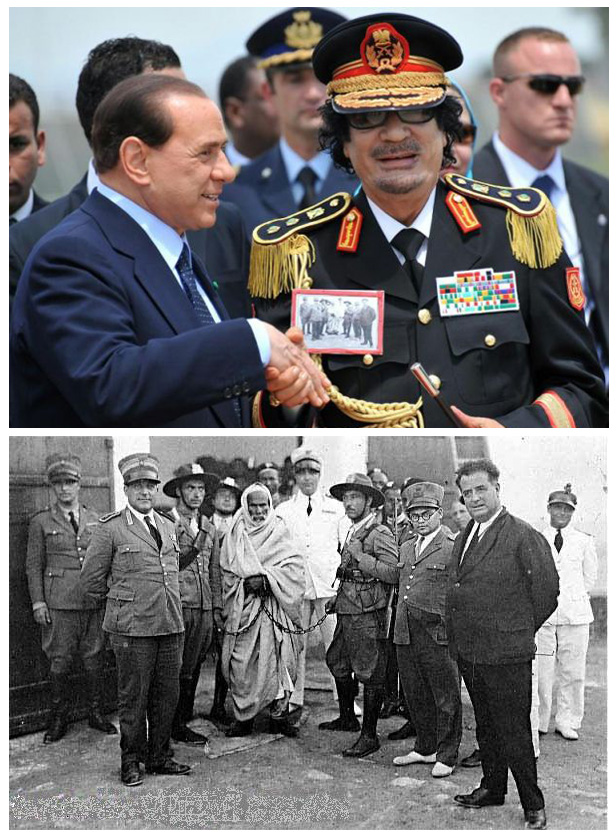 Ghedaffi visited the ex-Prime Italian Minister Berlusconi for the first time in June 2009. Ghedaffi wore on his jacket a picture of Mohammed Omar al-Mukhtar, the anti-colonialist fighter whom Italian occupiers hanged in 1931 under the military direction of General Rodolfo Graziani.
Ghedaffi visited the ex-Prime Italian Minister Berlusconi for the first time in June 2009. Ghedaffi wore on his jacket a picture of Mohammed Omar al-Mukhtar, the anti-colonialist fighter whom Italian occupiers hanged in 1931 under the military direction of General Rodolfo Graziani.
In the financial declaration of the 2004 Italian Government it was planned a special allocation for the construction of two CPT[14], in fact detention centers, in southern Libya and for a program of charter flights for the repatriation of “illegal immigrants” from Libya to their countries of origin. A report of the European Commission mission in Libya for a dossier on “illegal immigration” showed that Italy has provided to the Libyan army, for the risks that could lie during the transport of “illegal immigrants” from the CPT to their homelands, one thousand body-bags to the army, one hundred rubber dinghies, six off road vehicles, three coaches, five thousand diving suits, etc.
Since 2009, Italy donated to Tunisia patrol boats, radar patrol boats, marine engines, boats, off-road Mitsubishi Pajero tropicalised, quads, Iveco minibus, computer equipment, metal detectors and offered specialization courses (diver, forensic, jet skis, etc.) for the Tunisians cops to be held in Italy[15].
These are ways to militarize the border and international waters, to externalize the practices of borders control and the dirty work of the repression of migrants farther and farther away from the eyes and ears of the people in Italy, on the margins, in the more remote suburbs.
If it is already difficult to get information about what happens in the CIE who are on Italian soil it will be even more when the these are located away from the national coasts.
Immigrants are perpetually in a limbo between life and death. They risk death in the country in which they live, the risk in the “journey of hope” (see the hundreds of boats sunk in the Mediterranean Sea), the risk in the country in which they arrive (see the cases of deaths in detention centers for inhuman conditions in which they are forced to live), finally they risk when they are deported (see the thousands of deaths on the coasts and in the desert of Libya, or the violence and the tortures to which the defectors are subjected when they are deported to their countries with repressive governments, such as in Eritrea, Libya, Bangladesh, etc.)
Politicians and media mislead people saying that these tragedies should not happen again and that they act in the name of peace, freedom and justice, while at the same time they increase exponentially borders controls with security and deadly technologies, planes, boats and guards. So giving even more power to repressive Frontex and letting Europe become more and more an impermeable Fortress. What a hypocrisy!
It is clear, we are in a regime of Necropolitics.
The politics of regulation of death under global capitalism. In other words, the governamentality of death.
Antar Marincola: “The question of mobility it is a central one. It is connected to the question of borders. Borders are a big human manufacturing unfortunately is influencing many areas of the world because if you don’t have a valid passport… What does it mean to have a valid passport anyway? A passport from Europe, Canada, the United States, Japan, the Arab Emirates, the only Gulf area, but if you have a passport from Bangladesh, India, that’s a whole different story; if you don’t belong to an innermost circle, mobility – despite the fact that we are living in a time which is paradoxically very “mobile”- is not accessible to many people.
People move according to income, if people want to move from pillar to post they need impressively high credit account. And this is mainly dictated by the type of passport one holds.
I believe that today we need to better stabilize the citizenship issues in Italy, escaping the Ius Sanguinius and moving to the Ius Solis, but we also need to re-think the immigration policy of this country, not only within Italy but within the whole of Europe.
In Italy, for instance, it is obligatory for non-EU citizens to have their fingerprints taken when they arrive in Lampedusa for example, stated by the Dublin regulation, and then remaining in this country, unable to travel freely. It is unfair that Italy must be subjected to the various immigration flows coming from the Mediterranean space, without European support. The immigration is not an Italian, Spanish or Portuguese matter, it is a European one.”
The deportation of immigrants from Italy is regulated by the Pacchetto Sicurezza[16], a set of measures on immigration that date back to 2008, which in fact is an instrument of repression and criminalization of migrants.
The residency permit is obtained by points, a sort of “lottery” where the arbiters are those xenophobic racist politicians. The law has been provided by Roberto Maroni from the Northern League, at the time the Interior Minister.
For example 6 are the credits you get for the possession of a rental agreement in a housing market where “ethnic discriminations” are a common occurrence and where the rental highway robbery force the migrant to share an apartment with others, often with many others.
The increase of the rent can be used from the owner as blackmail in favor of the eviction and so the loss of the regular contract.
In addition, police makes random blitz to control the regularity of the rental agreement, when they found the minimal anomaly, migrants are “awarded” with deportation and the owner with high fines.
4 credits are given by choosing the doctor and this is quite paradoxical especially when migrant’s workers are forced to engage in seasonal work, kept in complete isolation and marginalization by inhuman conditions. Many of these workers are exploited in agriculture field of the rural south, in cities such as Rosarno, Castelvolturno, Alcamo, Cassibile, San Severo, Foggia e Napoli.
The duration of the working day is 8/10 hours. Half of the workers earn between 26 and 40 Euros per day while just over one-third earn 25 € or less. From this money everyday between 3 and 5 euros are assigned to the recruiter of day laborers, the man who is bringing every morning the workers on the field[17].
The living conditions are terrifying, often the land where they work is also the one where they sleep, other times they sleep in overcrowded abandoned buildings, in both cases without toilets, showers and drinking water. These people are getting sick because of the harsh conditions of life and work. They are left in a state of total abandonment. Sometimes in these places had to intervene the Doctors without Borders[18] organization that normally provide medical care in war contexts.
Additional points are then allocated to the academic records acquired in Italy, without considering that a large proportion of migrants have already qualified training, diplomas and specializations that our system considers waste paper. Moreover access to higher education remains a luxury for those who have strong family support networks, since scholarships and other incentives are insufficient.
The agreement is fulfilled when in two years 30 points are reached. If the person doesn’t get the right amount of points one-year extension is granted. Then expulsion is provided.
The Pacchetto Sicurezza is passed off as an instrument of integration but it is rather an instrument of exclusion that pushes the migrants to irregularity and illegality, a tool that represses and criminalizes instead of giving hospitality and support.
Those who manage to reach the coasts are immediately identified, if not voluntarily, by force. In this process the police is taking their fingerprints that get included in the central database of Eurodac.
The Dublin II Regulation establishes the criteria and mechanisms for determining the Member State responsible for examining an international protection application lodged by a Non-European or stateless person.
Often migrants protest and refuse to give their fingerprints because as Italy is the country of first arrival they cannot ask for the asylum in another European country where they may have relatives and want to live.
There are three kinds of structures where migrants are brought to: Care facility Centers (CDA) [19], Asylum seekers Centers (CARA)[20], Identification and Expulsion Centres (CIE)[21].
The CDA are structures that gives a first aid to “illegal alien” tracked throughout the country. The time at the center is “limited” to the one needed to establish the identity and the “legitimacy” of the stay on the territory (e.g. the refugee status) or to arrange a deportation. One of the most known is the Lampedusa one.
The CARA are structures where the alien asylum seekers without identity documents or who detracted from the border control are sent – for a period that goes from 20 up to 35 days – in order to identify them or to define the procedure for the recognition of the refugee status.
The CIE are detention centers where “irregular” Non-Eu people are waiting for deportation.
The stay in these centers goes from 180 days up to 18 months.
When these people enter in Europe they charged with the “criminal offense of illegal immigration” (“reato di clandestinità”) just because they were born in non-Eu state. They didn’t commit any crime however they are locked up in inhuman places, like the CIE. Overcrowded, with unacceptable hygienic conditions and health care, awful food, broken toilets and showers. For many years it was by law impossible for journalists, activists and associations for human rights to enter inside to witness the state of decay of the centers. Now it is still very difficult to get a permission and in some cases the authorities neglect the possibility to enter.
In 2011 through an emergency regulation in the CIE of Gradisca even the mobiles have been taken away from the prisoners to avoid any communication with the outside world. In the center it is not possible to do any recreational activity or socialization, even outdoors.
Common spaces like the canteen have been closed down, although it is perfectly feasible, because of the risk to allow an alliance among prisoners.
For the same reason, the time to spend in the courtyard has been drastically reduced.
It is not even allowed to keep books and newspapers and there are no sheets for the beds.
The Centers are completely militarized and surrounded by barbed wire.
Many are the cases of aggressions and violence from the guards as well as those of self-mutilation, and suicides. Razorblades gulped down. Veins cut. Neck cord. Hunger and thirsty strikes.
Accidents occur also while protesting. Recently few guys fall down from the roof of one center where they were manifesting their dissent toward the living conditions in the CIE and trying to get attention from outside.
I would not call this places Centers, I would rather call them Camps.
Camps of isolation, humiliation, violence, segregation, refusal, negation of human dignity.
The western states violate the human rights, the same they claim to support.
How many thousands of dead should we count before politicians will take the responsibility on that? How to face the brutality of us white citizens, which know what is going on but behave as nothing happen or they even provoke with racist statements and act?
The “brava gente” over time get used to what s/he sees and hears and is no longer posing questions. It stills believe in Europe who on a one hand win the Nobel prize for peace while on the other promotes superiority and a talent to oppress.
Are we really able to get used of everything?
IL MIO VENTRE DI SOMMOSSA IN BASSO RIBOLLE
Vulcanita Erupziono
2013
[1] http://www.affile.org/?s=storia-cultura&p=personaggi-illustri-rodolfo-graziani
[2] The word “manipular” is used to refer to a type of soldier from the Antique Rome.
[3] Original quote: Combattenti e coloni in A.O.I. (Africa Orientale Italiana). Al grande condottiero.
[4] Original quote: Die kameraden der deutschen Wehrmacht “Armata Liguria” fuer Ihren Oberbefehlshaber Feldmarschall R.Graziani.
[5] Original quote: Al maresciallo d’Italia Rodolfo Graziani. I suoi soldati delle campagne. D’Etiopia. Di Libia. D’Italia.
[6] Original quote: Le nostre mura crollano. I nostri cuori no (Linea gotica 1944/45)
[7] Original quote: Al soldato dell’onore Gen. Rodolfo Graziani. Comandante Supremo della guardia nazionale Rep.
[8] Under the video page (http://www.youtube.com/watch?v=k7SLlPd93cg) it is written: “the rally was dispersed after the current fascist regime in Ethiopia arrested more than 40 of the organizers.” Could this be a manifestation of how fascism and colonialism continue to co-exist?
Other initiatives and protests organized against the memorial can be find here:
– Atlanta (Georgia) “Ethiopians living in and around Atlanta, Georgia, on Sunday condemned the horrendous crimes Italian Fascists committed during the WWII. The event also condemns the erection of a statue in honor of Fascist Grazziani, dubbed the “Butcher of Ethiopia.” http://www.youtube.com/watch?v=VKud9AXteW0
– Washington where Ethiopians denounce Italy: “Affile is A Disgrace to Italy”. http://www.youtube.com/watch?v=7w6O6f1rl-E
– In New York it was organised on the 31st January 2013 by Centro Primo Levi and the Calandra Italian American Institute a panel discussion called “Honoring a War Criminal. The Monument to Rodolfo Graziani” where has been discussed Graziani’s role in Italian colonialist wars in Africa as well as his interventions in domestic politics and it will also address the failure of international sanctions and protests against the first use of poison gas against civilians. For more information look at: http://www.youtube.com/watch?v=OZseMG9ro8A
[9] The reconstruction of the violated imaginary in three Italian-speaking writers of the Horn of Africa, Igiaba Scego, PhD thesis in Pedagogy, 2007/2008
[10] Berlusconi is said “the Knight” because of the “Knight of the work” commendation, in the working sector Construction industry and Telecommunication, received in 1977 from the Italian Republic President Giovanni Leone, Demo-Christian politicians who in his political career was even inscribed in the National Fascist Party.
[11] The public memory and the media: the case of Italian colonial past, Paolo Jedlowski
[12] Info taken from: http://www.info-cooperazione.it/2013/07/se-saranno-i-vip-a-raccontare-la-cooperazione/
[13] The photo competition archive can be found on: http://www.ed4bg.eu/photo_contest.html
[14] The CPT, Center for temporary stay, has been substituted with the Legislative decree n. 92 of the 23rd 2008 with CIE, Center of identification and expulsion.
[15] For more info on the agreement between Italy and Tunisia: http://www.narcomafie.it/2013/03/05/i-gravosi-impegni-italiani-con-tunisia-e-libia-per-il-controllo-dellimmigrazione-via-mare/
[16] Literally translated as Security Package.
[17] Info taken from http://www.ilsole24ore.com/art/SoleOnLine4/Italia/2009/09/immigrati-viaggio-lavoro-sud.shtml
[18] For more information on the conditions of workers migrants employed in agriculture in the south of Italy (Campania, Lazio, Puglia, Calabria, Basilicata, Sicilia): http://www.medicisenzafrontiere.it/Immagini/file/pubblicazioni/una_stagione_all_inferno.pdf
[19] Original name: Centri di accoglienza
[20] Original name: Centri di accoglienza richiedenti asilo
[21] Original name: Centri di identificazione ed espulsione
[iii] 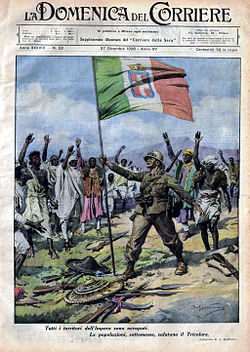 [iv]
[iv] 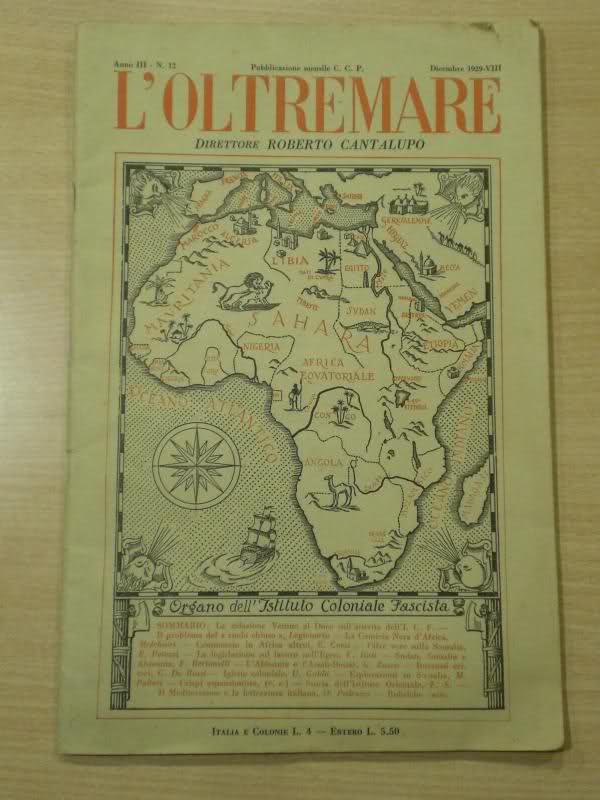
[v]